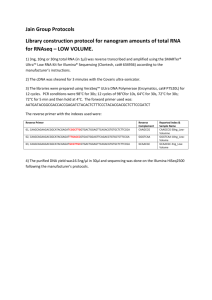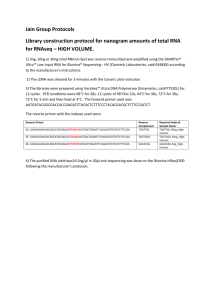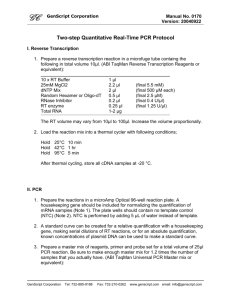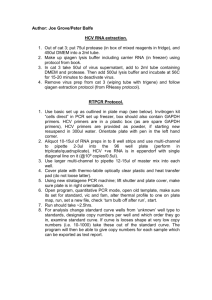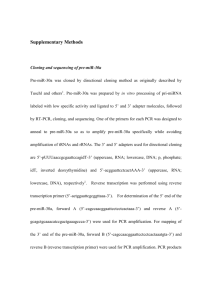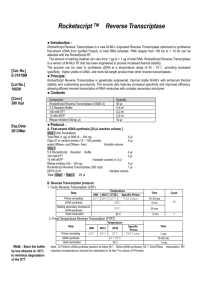One Step Quantitative Real-Time PCR Protocol
advertisement
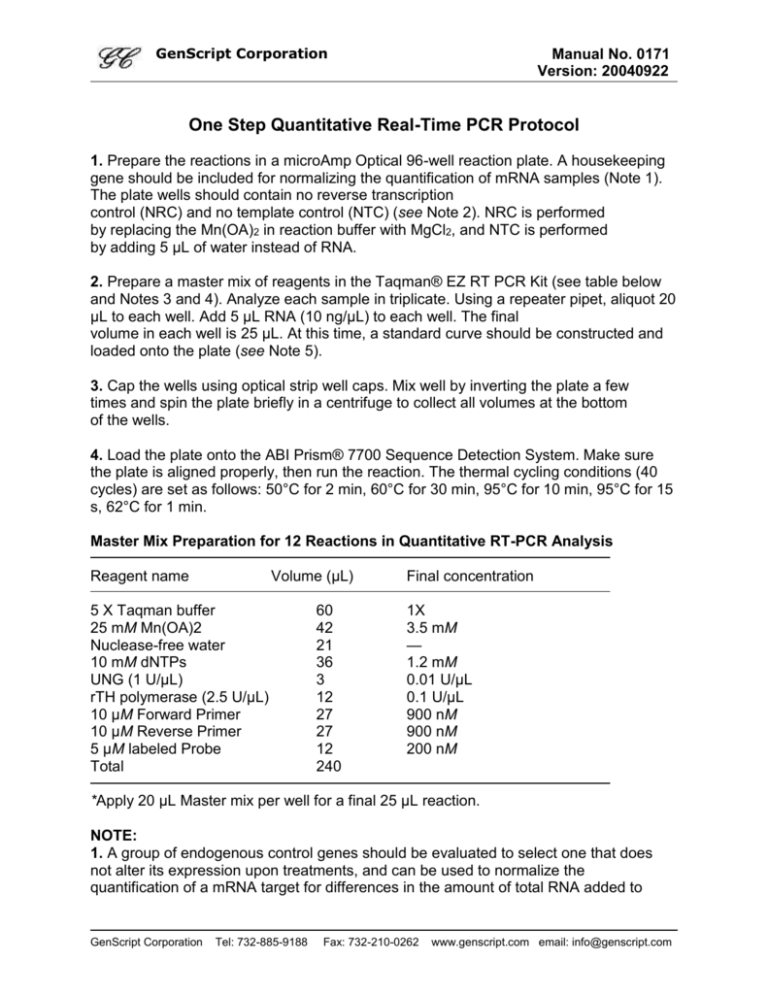
GenScript Corporation Manual No. 0171 Version: 20040922 One Step Quantitative Real-Time PCR Protocol 1. Prepare the reactions in a microAmp Optical 96-well reaction plate. A housekeeping gene should be included for normalizing the quantification of mRNA samples (Note 1). The plate wells should contain no reverse transcription control (NRC) and no template control (NTC) (see Note 2). NRC is performed by replacing the Mn(OA)2 in reaction buffer with MgCl2, and NTC is performed by adding 5 µL of water instead of RNA. 2. Prepare a master mix of reagents in the Taqman® EZ RT PCR Kit (see table below and Notes 3 and 4). Analyze each sample in triplicate. Using a repeater pipet, aliquot 20 µL to each well. Add 5 µL RNA (10 ng/µL) to each well. The final volume in each well is 25 µL. At this time, a standard curve should be constructed and loaded onto the plate (see Note 5). 3. Cap the wells using optical strip well caps. Mix well by inverting the plate a few times and spin the plate briefly in a centrifuge to collect all volumes at the bottom of the wells. 4. Load the plate onto the ABI Prism® 7700 Sequence Detection System. Make sure the plate is aligned properly, then run the reaction. The thermal cycling conditions (40 cycles) are set as follows: 50°C for 2 min, 60°C for 30 min, 95°C for 10 min, 95°C for 15 s, 62°C for 1 min. Master Mix Preparation for 12 Reactions in Quantitative RT-PCR Analysis Reagent name Volume (µL) 5 X Taqman buffer 25 mM Mn(OA)2 Nuclease-free water 10 mM dNTPs UNG (1 U/µL) rTH polymerase (2.5 U/µL) 10 µM Forward Primer 10 µM Reverse Primer 5 µM labeled Probe Total 60 42 21 36 3 12 27 27 12 240 Final concentration 1X 3.5 mM — 1.2 mM 0.01 U/µL 0.1 U/µL 900 nM 900 nM 200 nM *Apply 20 µL Master mix per well for a final 25 µL reaction. NOTE: 1. A group of endogenous control genes should be evaluated to select one that does not alter its expression upon treatments, and can be used to normalize the quantification of a mRNA target for differences in the amount of total RNA added to GenScript Corporation Tel: 732-885-9188 Fax: 732-210-0262 www.genscript.com email: info@genscript.com GenScript Corporation Manual No. 0171 Version: 20040922 each reaction. Commonly used endogenous control: genes encoding acidic ribosomal protein, cyclophilin, glyceraldehyde-3-phosphate dehydrogenase, â-glucuronidase, and hypoxanthine ribosyl transferase. 2. NRC is used to check for genomic DNA contamination in RNA samples. Mn2+ is crucial for reverse transcription. Doing NRC once is enough, if the same RNA samples are used in experiments with different genes. In addition, NTC must be included in each plate every time for each tested gene. This is a good control for checking for any contamination in primer/probe mix or formation of primer dimer. 3. Be sure to make enough master mix for 1.2 times the number of samples that you actually have. 4. One-step RT-PCR is ideally suited for high sample throughput and provides the additional benefit of high-temperature reverse transcription, with a single enzyme for ease of use. The enzyme is recombinant Thermus thermophilus (rTth) thermostable DNA polymerase, which reverse transcribes RNA to cDNA in the presence of Mn2+ ion and polymerizes DNA during the PCR amplification. High-temperature (60–70°C) reverse transcription with rTth DNA polymerase permits efficient cDNA synthesis from RNA templates that contain a complex secondary structure or high G + C content. 5. For relative quantification, any stock RNA sample containing relatively abundant RNA of the target gene can be used as a template for determining a standard curve, which can be established by analyzing a serial dilution of a known concentration of an RNA sample. The standard curve also provides a validation or an insight into the PCR efficiency for a particular primer/probe set. GenScript Corporation Tel: 732-885-9188 Fax: 732-210-0262 www.genscript.com email: info@genscript.com
